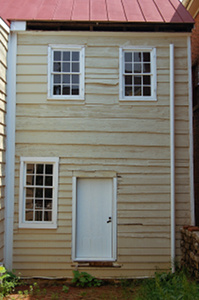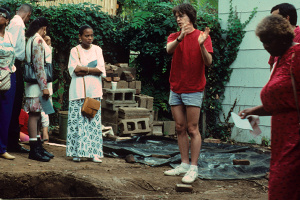THE MAYNARD-BURGESS HOUSE

Pride and resilience are the words that best sum up the history of the Maynard-Burgess House. The Maynard-Burgess House, currently owned by the City of Annapolis and administrated by the Historic Annapolis Foundation, can be seen as the embodiment of Annapolis' African American past, wrapped up into one uniquely rich site. Continually owned by two interrelated African American families, from about 1850-1980, the house and its residents bore witness to changes in African American lives that ran from slavery, to the Civil Rights movement, to the present day. From 1990-1992 Archaeology in Annapolis excavated the Maynard-Burgess house as part of its annual field school. Insights gained as a result of work at this site have illuminated the strategies by which one household negotiated a continued fight for equality spanning the late 19th and 20th centuries.
Many Rivers to Cross
John Maynard was born in Anne Arundel County, Maryland in 1810. His status as a free man of color afforded him relatively little peace of mind in a county whose population was comprised of up to 50% slaves. At the age of 21, John Maynard officially received his certificate of freedom. Three years later he purchased the freedom of his wife, Maria Spencer Maynard, and her three-year old daughter, Phebe Ann Spencer. In 1845, John Maynard bought what was to later be known as the Maynard-Burgess House, then in 1847, Maynard purchased the freedom of Maria's mother, Phebe Spencer.
According to census records, John Maynard appears to have been a waiter for much of his life and more than likely worked at Annapolis' City Hotel, directly across the street from John and Maria's house. Financially, the Maynard's appear to have been among Annapolis' more affluent African American families, with the household's total estate valued at $525 in 1849. Their status as free African Americans and their relative financial well-being made the Maynard's appear somewhat conspicuous within the context of 19th-century Annapolis.
John Maynard died in 1875. Survived by Maria and extended family members, the household took in boarders in the lean years. After the death of Maria between 1880-1900, the house was sold to a former boarder, Willis Burgess. The house remained in the Burgess family hands for the next 80 years and remained relatively undisturbed-a perfect opportunity for archaeological investigations that sought to document and understand the lives of these two families.
Managing the Market
Set within the racially charged environment of pre-and-post Civil War Annapolis, the history of the Maynard-Burgess House's inhabitants is representative of many 19th and early 20th century African Americans living in the City. African Americans developed tactics for daily survival that permitted them to circumvent high prices and poor-quality goods while at the same time remaining inconspicuous so as not to become the target of discriminatory action. Archaeological evidence, recovered from three field seasons, points to several strategies that were utilized by the Maynard-Burgess household throughout the 19th and early 20th centuries as a means of circumventing and covertly fighting racism. The story of John Maynard and the Maynard-Burgess House inhabitants can be seen as the tangible, material component of the fight for equality.

Archaeology in Annapolis excavations recovered thousands of fish scales and bones from the Maynard-Burgess House backyard and from under a porch addition. While seemingly a rather innocuous discovery, this finding suggests that the Maynard-Burgess house inhabitants were fishing, and then cleaning the fish in the backyard. It is known historically that fresh, pre-cleaned fish was widely available in the local Annapolis market if African Americans were willing to pay the artificially high prices imposed by some white grocers. The archaeological recovery of numerous tin cans and bottles bearing national brands-goods available at fixed prices through the mail-stands as corroborating evidence for this interpretation of consumer activity as an opportunity to guarantee fair prices.
Further Reading
Mullins, Paul R.
1999 Race and Affluence: An Archaeology of African America and Consumer Culture, 1850-1930. New York:
Plenum Press.
1999 "A Bold and Gorgeous Front": The Contradictions of African America and Consumer Culture. In Historical Archaeologies of Capitalism. Edited by Mark P. Leone and Parker B. Potter, Jr. New York: Kluwer Academic/Plenum Press, pp.169-193.
1999 Race and the Genteel Consumer: Class and African-American Consumption, 1850-1930. In The Historical Archaeology of Class. Edited by Lou Ann Wurst and Robert Fitts. Historical Archaeology 33/1:22-38.
1998 Expanding Archaeological Discourse: Ideology, Metaphor, and Critical Theory in Historical Archaeology. In Annapolis Pasts: Historical Archaeology in Annapolis, Maryland. Edited by Paul A. Shackel, Paul R. Mullins, and Mark S. Warner. Knoxville: University of Tennessee Press, pp.7-34.
Warner, Mark S.
1998 "The Best There is of Us": Ceramics and Status in African-American Annapolis. In Annapolis
Pasts: Historical Archaeology in Annapolis, Maryland. Edited by Paul A. Shackel, Paul R. Mullins,
and Mark S. Warner. Knoxville: University of Tennessee Press, pp.190-212.
1998 Food and the Negotiation of African-American Identities in Annapolis, Maryland and the Chesapeake. Ph. D. dissertation, Department of Anthropology, University of Virginia. Ann Arbor: University Microfilms International.



